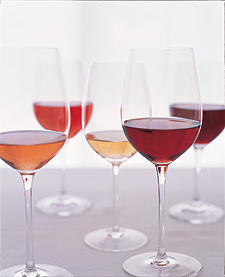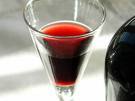The Wikipedia needs help on rosé, and I am just the guy who can do it!
VI. No rules I said. I can find no generalization in the rosés I know. The foggies stuck with Mateus will say sweet and pink. The first is easily disproved. Many of the rosés are bone dry on the finish. Indeed dryer than some red and white table wines. So, stow that weary canard! Pink, hmm. The range of colour is wide. See!

I don’t think we can call a Bandol Tempier Rosé pink.  Not hardly pink but copper, yes. In contrast many are just plain red, and all points in between.
Not hardly pink but copper, yes. In contrast many are just plain red, and all points in between. 
That copper colour, I have learned to trust. It is a recognized style in rosé from Sancerre in France. (There are others, like Clarette from the Gironde.) It is that amber, copper colour with a raspberry tingle at the end and a bone dry finish. Most but not all these Sancerre style wine are made by the saignée method, a gentle bleeding off of the juice after only brief skin contact. Note that the saignée method is used to make other kinds of wine, too. Wikipedia needs help on this method and on rosé in general. Not even that goddess of the grape Jancis Robinson does justice to rosé, though she comes closer to that ethereal standard than anyone else. http://www.jancisrobinson.com/
As rosé has come back into fashion, every winemaker now does one, that is, except for that redoubtable bastion of tradition in the Australia wine industry – think cork – in the Swan Valley of Western Australian, Houghton’s, which has yet to produce one, and I am no longer as ubiquitous in my tasting. I have sipped too many duds.
But there was a time when there was virtually no market for rosés and winemakers who made it did so because they wanted to, I suspect one reason some of them wanted to do so, was because there were no rules. They could use the grapes they had; they could make the kind of wine they wanted to make, not limited to the kind of wine the marketing consultant said would sell. Hence that dizzying variety of grapes that go into rosé.
Equally there is a palate spinning host of favours in these rosés. You may not like the austere Sancerre style that I do but there are plenty of others. Many of them are light red wine with that cherry flavour some people like a lot. Others are delicate, white wines with a little colour. Break with the past and give rosé a try in the warm weather. It is such a fashion today I have found a couple of rosés with oak aging, That is worth a comment because oak barrels are expensive. Myself I don’t like oak in anything but red wine, but jokes for folks.
“Think cork,” I said. That might have been too cryptic for the dullards. Houghton’s sticks to corks to seal the bottles of its divine, and after much foot dragging, only recently renamed White Classic (previously White Burgundy). (I entered the contest to re-name this wine years ago with the brilliant suggestion that it be named after the wine maker who created it in the 1930s Jack Mann. Strangely I did not win the prize. One suspects the worst. A fix.)
To be continued.
